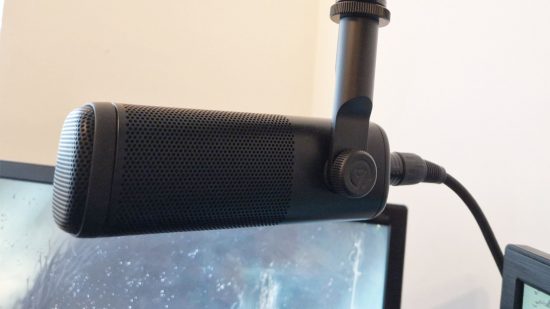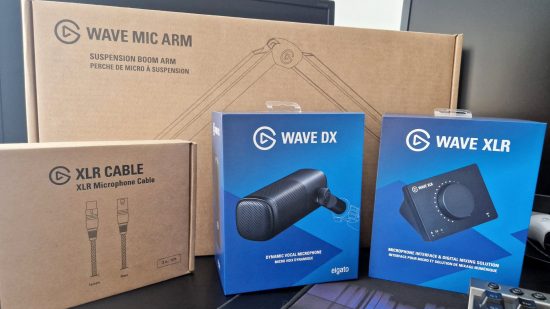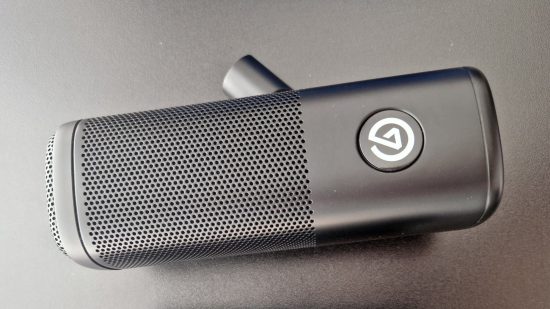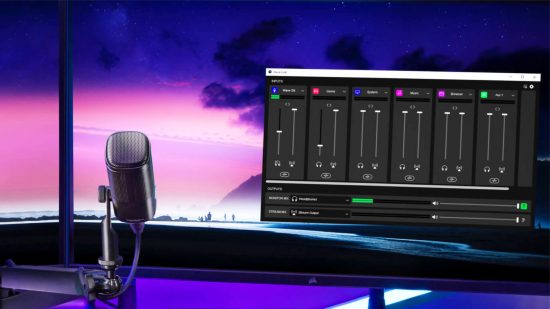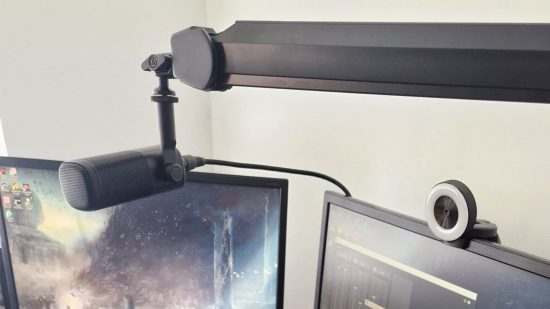Our Verdict
A dynamic streaming microphone with ultra-crisp sound quality that elevates your setup to a professional level without breaking the bank.
To say that the Elgato Wave DX has some mighty shoes to fill is something of an understatement, considering the Elgato: Wave 3 has long stood as Corsair’s top streaming microphone. Ditching USB in favour of an XLR cable, the new flagship isn’t quite as streamlined since it needs extra kit to work, but it raises the bar for streamers looking for better audio quality to carry their dulcet tones.
Elgato isn’t just gunning to make the best gaming microphone, it’s carved out a name for itself as the brand for professional streamers. It offers just about everything a content creator needs, from the best capture card, to webcams, to green screens. Even its Wave XLR preamp curiously predates its new dynamic XLR microphone for some reason.
It’s difficult to talk about the Elgato Wave DX without also discussing the Wave XLR audio interface and Wave Link software. XLR microphones need a preamp in order to function, and while you can use just about any interface, it’s immediately apparent that the Elgato Wave DX was designed with this particular peripheral in mind.
USB microphones are generally known to have the edge over XLR in convenience and portability. However, the Elgato Wave DX is about as plug-and-play as you can get. Setup is incredibly intuitive, and doesn’t take an audio engineer; connecting the Elgato Wave DX and Wave XLR to your PC is simply a matter of plugging in a couple of cables, and away you go.
Design
The Elgato Wave DX boasts an angular design that’s a bit smoother than others in the series, giving it an air of professionalism that sets it apart from competitors. It’s also noticeably heavier than entry-level streaming microphones – it feels expensive to handle, just as much as it looks.
Equally, it’s not a microphone that demands to be seen. It’s discreet enough that it won’t draw the eye, regardless of whether you choose to include it on camera or not. The lack of a pop filter might be disconcerting at first, but I’m happy to report that the Elgato Wave DX includes an internal pop filter, which means you never have to worry about wrangling an unwieldy shield, or hunting down a foam sleeve that fits.
Unlike the Elgato Wave: 3, the Elgato Wave DX doesn’t come with its own stand attached. It does include 3/8″ and 5/8″ thread adapters to connect to compatible mic stands, but if you’re without any existing kit, it’s an additional cost that you’ve got to factor in alongside your purchase.
The ideal Elgato Wave DX mount largely depends on the kind of content you’re creating. There’s an additional mini mount you can pair with the Elgato Wave DX which is a great option for podcasts, but the high-rise boom arm is guaranteed to cut down on impact vibrations caused by a keyboard. Both mount options are easily manipulated to suit your needs, but it’s worth mentioning that the boom arm is chonky, and has enough reach to comfortably extend across a monitor. The matte finish also picks up fingerprints incredibly easily, which is a minor annoyance if you need to adjust your setup regularly.
The Wave XLR audio interface serves as the supporting act to the Elgato Wave DX, but it, too, is an inconspicuous addition to your workstation. The interface is characterised by a single control dial and LEDs denoting your input gain and output volume. Making audio adjustments from your workstation is a welcome alternative to dragging sliders around with your mouse, and the mute control is highly responsive, activating with the gentlest touch to the back of the Wave XLR.
All in all, the Elgato Wave DX, boom arm, and Wave XLR make for a professionally innocuous audio setup, and if you’re partial to a sleek black workstation, these peripherals will feel right at home on your desk.
Sound and performance
While operating at the recommended 45dB, the Elgato Wave DX is startlingly crisp, and testing the upper limits of its input made me feel like I was a budding ASMRtist. Remember, the Elgato Wave DX is a dynamic microphone, so it’s more than capable of holding its own without any additional assistance from 48V phantom power.
Condenser microphones are ideal for small, soundproofed offices, but if your streaming setup is in your living room or communal space, you can all but guarantee that any peripheral sound will make it onto your recording without the aid of something like Nvidia Broadcast. By contrast, the Elgato Wave DX can filter out as much background noise as required via a few adjustments of Wave Link, without affecting your voice quality. It particularly excels at minimising the dull thumps and thuds of doors closing, or pets getting up to mischief.
An XLR microphone’s sound quality is undeniably greater than that of a bog-standard USB microphone, but the type of sound a dynamic mic produces can sometimes be described as a bit flat in comparison to a condenser microphone’s richer tones. This holds true for the Elgato Wave DX, but I find it better suited to isolating voice commentary against the backdrop of music, dialogue, and sound effects produced by a video game.
Elgato recommends a distance of 8-12cm for optimal voice capture, a minor cause for concern for anyone who prefers their microphone to be heard and not seen while streaming. However, if there is a drop in sound quality while using it at a distance of 18-20cm, it’s so minor as to be unnoticeable. In fact, you don’t have to feel self-conscious about how far away you are from your microphone at all thanks to its very reasonable cardioid polar pattern, which retains voice sensitivity even while speaking in a different direction.
Software
Elgato’s Wave Link software is an additional application to monitor while streaming, but the minimalism of the user interface keeps it lean and intuitive. Each audio source is represented by two simple sliders, one for your monitor output, and one for your stream output. Once you balance them accordingly, you can link both faders together to adjust both volumes simultaneously.
Juggling audio sources in OBS can be an endless source of frustration, but Wave Link allows you to easily adjust your sound levels to always ensure your microphone’s output is standing head and shoulders above whatever audio source you’re playing alongside it. You can even isolate your stream mix to hear exactly what your stream is hearing, and rectify audio issues affecting your viewers without having to rely on them to diagnose problems for you.
When paired with Wave Link, the Elgato Wave DX can also take advantage of Clipguard, Lewitt’s anti-distortion technology specifically designed to prevent clipping or peaking. It’s an incredibly useful feature that can be activated simply by checking a box, at which point you can forget all about it. That said, operating the Elgato Wave DX at the recommended 45dB showed no trace of gain reduction, even while putting it through its paces during a high-intensity stream.
Verdict
The Elgato Wave DX is a world away from budget streaming microphones like the Razer Seiren X, and it’s an excellent choice for anyone who wants to take the leap into XLR streaming microphones. The microphone alone costs $99.99 USD / £109.99 GBP, which is a shockingly good price compared to other dynamic XLR microphones, such as the strangely popular Shure SM7B, and its sound quality is undeniably top-tier.
However, if you’re not already kitted out with a compatible arm mount and audio interface, you can expect to shell out at least $289.99 USD / £309.99 GBP for the full Elgato Wave DX bundle. While it’s undoubtedly a hefty price tag, it’s worth bearing in mind that you’re not just getting a microphone, you’re getting a full audio kit, along with access to the software that allows it to perform at its best
Ultimately, the Elgato Wave DX is an excellent choice for content creators looking to take their audio quality to the next level. It comfortably fills the gap between the low-budget and ultra-professional, neither of which are really appropriate for the average streamer. It’s a great first step into the world of dynamic XLR microphones, delivering voice clarity that’s a cut above the usual suspects marketed to streamers.
